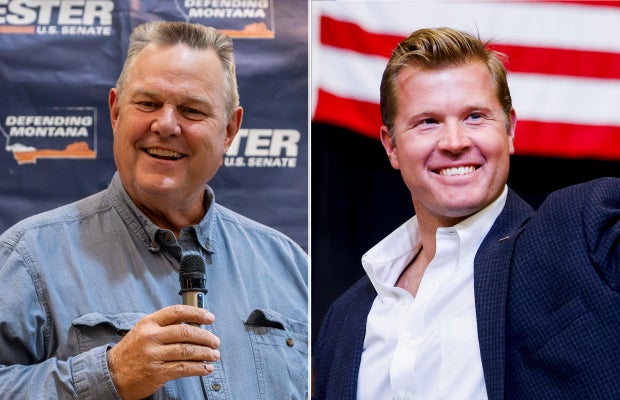CBS News
Montana 2024 Senate race has Jon Tester facing reelection challenge from Tim Sheehy

Sen. Jon Tester and Republican challenger Tim Sheehy are facing off in Montana as the Democratic incumbent fights to hold onto his seat in the Senate in a race that’s key to determining which party controls the upper chamber.
Considered the most endangered Democrat seeking reelection in the Senate this cycle, Tester, a moderate in deep-red Montana, has been under the political microscope for months as he campaigns to keep the seat he’s held for nearly two decades. Although the 68-year-old has fended off previous challenges, shifting demographics and political dynamics in the state appeared to enhance the pickup opportunity for Republicans in the 2024 election.
Sheehy, a former Navy SEAL and founder of an aerial firefighting company, received his party’s backing as the candidate to take on Tester. The 38-year-old worked to draw a contrast with Tester, portraying himself as an outsider during the campaign while painting the Democrat as an establishment candidate with deep ties to Washington. He also touted bringing jobs to Montana with his business, which made him wealthy enough to help fund his campaign.
Getty Images
Sheehy, who grew up in Minnesota, has faced criticism for lacking the deep roots that Tester has in the state. He has also faced questions about discrepancies in his story of how he sustained a gunshot wound. Meanwhile, Tester sought to portray his opponent as an out-of-touch carpetbagger, likening the GOP candidate to rich out-of-staters who have flocked to Montana in recent years.
Tester is a third-generation Montana farmer. First elected to the Senate in 2006, his brand is well known in the state, and despite its more conservative politics, he’s won reelection twice as a moderate Democrat.
But Montana’s political landscape has changed. In 2020, Donald Trump won Montana by more than 16 points, and trends suggest that an influx of new residents in the state is made up largely of Republicans. The state’s changing dynamics posed a serious hurdle for Tester — the sole Democrat serving in statewide office in Montana.
The Montana Senate seat is a key target for Republicans looking to build a GOP majority in the upper chamber. And it marks among the final Democratic holdouts in the Great Plains, and in red states more broadly.
With a narrow 51-49 majority in the Senate, Democrats have little room for error. After Sen. Joe Manchin opted not to seek reelection, all but guaranteeing a GOP flip of his seat in West Virginia, Republicans looked to Tester’s seat as the next best opportunity to gain ground.
CBS News
Benjamin Netanyahu fires Israel’s defense minister Yoav Gallant

Watch CBS News
Be the first to know
Get browser notifications for breaking news, live events, and exclusive reporting.
CBS News
3 smart gold investing moves to make right now

Getty Images/iStockphoto
Gold has proven itself as one of the most resilient assets of the year, displaying remarkable growth so far in 2024. Starting the year at $2,063 per ounce, the price of gold is now sitting over $2,748 per ounce, slightly below its recent record high. As a result, investors who bought gold earlier this year — or even just a few months ago — have already reaped notable returns, a big benefit of this exceptional price trajectory.
Historically, though, gold’s value tends to increase more gradually, offering stability rather than swift gains. Still, most analysts believe the current upward trend could hold, driven by factors such as economic uncertainty, central bank policies and geopolitical tensions. So while gold’s current upward trajectory might be uncommon, it could persist for the near future, making the precious metal an attractive choice for both new and seasoned investors.
But if you’re considering entering the gold market or adjusting your existing precious metals holdings, there are a few strategic moves you can make to help maximize the potential benefits of gold investing in the current environment.
Diversify your portfolio by investing in gold today.
3 smart gold investing moves to make right now
If you’re planning to invest in gold in today’s market, consider making these moves:
Add physical gold to your portfolio
During periods of rising gold prices, acquiring physical gold can be particularly advantageous, despite having a higher entry point than other gold options. That’s because physical gold offers several distinct benefits that become especially valuable in a bullish market. For starters, when you own physical gold, whether in the form of gold bars or coins, you have direct ownership of a tangible asset that isn’t subject to counterparty risk or financial system vulnerabilities.
Physical gold that is purchased during price uptrends also typically benefits from momentum in the market. While past performance doesn’t guarantee future results, strong upward price movement typically attracts more investors, potentially creating additional demand that could further support prices. The tangible nature of physical gold also provides a psychological benefit, as having direct possession of your investment can offer peace of mind during periods of market volatility.
Find out what your gold investing options are here.
Consider your digital gold options
While physical gold has its merits, digital gold investments, particularly gold stocks, often provide amplified returns during gold bull markets. That’s because mining companies typically see their profits increase at a faster rate than the price of gold itself due to their operational leverage. For example, if a mining company’s cost to produce an ounce of gold remains relatively stable while the selling price increases substantially, the company’s profit margins expand significantly.
As a result, gold mining stocks, especially those of well-established companies with strong production profiles and healthy balance sheets, can offer exposure to gold’s price movements while also providing additional benefits like dividend payments. And gold exchange-traded funds (ETFs) that track either the price of gold or baskets of gold mining stocks offer another convenient way to gain exposure to the sector, often with lower transaction costs and greater liquidity than physical gold.
Make sure you’re investing the right amount
Perhaps the most crucial decision in gold investing isn’t just whether to buy, but how much to allocate to this precious metal. Financial advisors typically recommend limiting gold exposure to a maximum of 10% of your overall investment portfolio. This measured approach serves multiple purposes in your investment strategy.
The 10% ceiling allows you to benefit from gold’s potential upside while maintaining sufficient diversification across other asset classes. This balance is essential because, while gold can provide valuable portfolio protection during certain market conditions, it’s important to remember that other assets — like stocks, bonds and alternative investments — typically provide different types of returns and benefits, including regular income through dividends or interest payments.
Maintaining this disciplined allocation helps ensure that your portfolio remains well-balanced and aligned with your long-term financial goals. Even during periods of strong gold performance, resisting the temptation to overweight your portfolio toward gold helps manage risk effectively. Remember, the primary role of gold in most portfolios is to serve as a hedge against uncertainty and inflation, not necessarily as the main driver of returns. That’s just an added bonus.
The bottom line
While gold’s recent price performance has caught many investors’ attention, success in gold investing still requires a thoughtful, measured approach. By considering physical gold ownership, exploring your digital gold options and maintaining appropriate allocation levels, you can potentially benefit from gold’s current strength while managing your overall portfolio risk effectively.
CBS News
Israeli Prime Minister Benjamin Netanyahu fires his defense minister, Yoav Gallant

Israeli Prime Minister Benjamin Netanyahu on Tuesday dismissed his popular defense minister, Yoav Gallant, in a surprise announcement that came as the country is embroiled in wars on multiple fronts across the region.
Netanyahu and Gallant have repeatedly been at odds over the war in Gaza. But Netanyahu had avoided firing his rival. Netanyahu cited “significant gaps” and a “crisis of trust” between the men in his Tuesday evening announcement.
“In the midst of a war, more than ever, full trust is required between the prime minister and defense minister,” Netanyahu said. “Unfortunately, although in the first months of the campaign there was such trust and there was very fruitful work, during the last months this trust cracked between me and the defense minister.”
In the early days of the war, Israel’s leadership presented a unified front as it responded to Hamas’ Oct. 7, 2023, attack. But as the war dragged on and spread to Lebanon, key policy differences have emerged. While Netanyahu has called for continued military pressure on Hamas, Gallant had taken a more pragmatic approach, saying that military force has created the necessary conditions for a diplomatic deal that could bring home hostages held by the militant group.
ABIR SULTAN/POOL/AFP via Getty Images
Gallant, a former general who has gained public respect with a gruff, no-nonsense personality, said in a statement: “The security of the state of Israel always was, and will always remain, my life’s mission.”
Gallant has worn a simple, black buttoned shirt throughout the war in a sign of sorrow over the Oct. 7 attack and developed a strong relationship with his U.S. counterpart, Defense Secretary Lloyd Austin.
A previous attempt by Netanyahu to fire Gallant in March 2023 sparked widespread street protests against Netanyahu. He also flirted with the idea of dismissing Gallant over the summer but held off until Tuesday’s announcement.
Gallant will be replaced by Foreign Minister Israel Katz, a Netanyahu loyalist and veteran Cabinet minister who was a junior officer in the military. Gideon Saar, a former Netanyahu rival who recently rejoined the government, will take the foreign affairs post.
Netanyahu has a long history of neutralizing his rivals. In his statement, he claimed he had made “many attempts” to bridge the gaps with Gallant.
“But they kept getting wider. They also came to the knowledge of the public in an unacceptable way, and worse than that, they came to the knowledge of the enemy – our enemies enjoyed it and derived a lot of benefit from it,” he said










